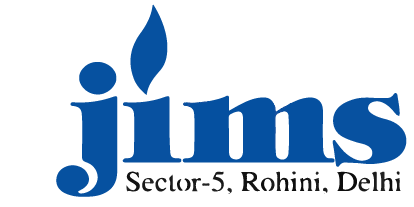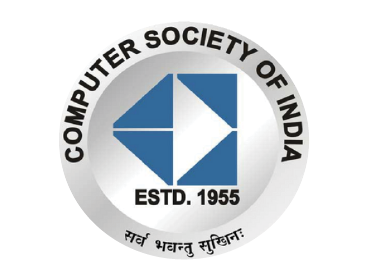Blockchain: An Innovative Technology
Faculty Mentor:
Dr.C.Komalavali
Student Name:
Prachi Sharma (MCA-3rd Year)
Reena Garg(MCA-3rd Year)
ABSTRACT
Since the beginning of Blockchain, it has become a hype in the field of technology. In November 2008, Satoshi Nakamoto wrote a white paper that took a big leap all over the internet. The paper described a method to create a fully distributed digital currency system by cryptographically linking the blocks of data together. He only introduced the name BLOKCHAIN for the distributed ledger. In this article, we are going to dip deeper about Blockchain concepts, working of a blockchain and how it is revolutionizing the whole world.
1. INTRODUCTION
Blockchain: as the name suggests, is a chain of blocks. Blockchain is a decentralized, distributed ledger technology of chain of records, called as Blocks, which are linked cryptographically.
Blockchain is an emerging technology was invented by Satoshi Nakamoto in 2008. It was first emerged as a platform to provide a tamper-proof and transparent way of exchange of cryptocurrencies without the involvement of any intermediaries. It gained its prominence with the emergence of Bitcoins as proving a trusted way of cryptocurrency transactions. After that, it has received a lot of attention in the field of technology and financial industry as well, because of most trusted and promising way of currency exchanges ever.
The Blockchain is the trust machine indicating that it is a system, making the transactions trust-free by providing decentralized transparent system (Economist, 2015).
2. UNDERSTANDING THE TECHNOLOGY
In the current scenario of digitalization, one of the major concern is data security. While sharing some information over the internet, the main concern is that the information should be authenticated and tamper-proof. Till some point, this has been succeeded successfully. But the concern yet remains somewhere.
Blockchain technology then came into effect and considered as an innovative technology. The motivation behind why Blockchain technology considered as innovative is its ability to solve the problem of authenticity, exchange of tamper-proof and transparent data without the involvement of any intermediaries.
While, Blockchain emerged as a platform of exchanging cryptocurrencies such as Bitcoin, it is not limited to this only. The platform now involves any kind of exchange of data records including assets and goods, votes, etc. Clearly, with Blockchain and distributed ledgers, it is revolutionizing the world with its trust, reliability and transparent nature.
2.1 WHAT IS BLOCKCHAIN?
Blockchain technology is a series of data blocks that are cryptographically chained together. Each block contains a cryptographic hash of previous block, a timestamp(when the block created) and the information to be shared. So, originally speaking, Blockchain is nothing more than a mere data structure with distributed type system.
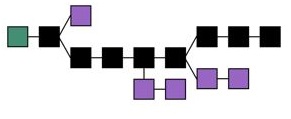
Since Blockchain is a distributed ledger, creating a distributed network of participant called as Nodes, each node contains a full copy of Blocks on its side. Each Nodes copy is updated in real-time whenever a transaction takes place anywhere, over the Blockchain network.
The Blockchain becomes unique because of the reason that each node has to authenticate every transaction in the network and thus, not following the method of centralized system.
Another feature which makes it trusted is its immutability. Once the blocks are added in the chain, they cannot be tampered.
2.2 WHY BLOCKCHAIN?
When the exchange of money or goods takes place between buyers and sellers, some key attributes of transaction need to be verified by the parties involved. Suppose in case of transferring money from one account to another, the intermediary involved here is the bank. Buyers and sellers have to trust the intermediaries for their own transactions. What intermediaries do is add value to marketplaces and risk of moral hazard through third-party verification. This includes forcing extra disclosures, monitoring participants and maintaining trustworthy system. This thus becomes more valuable and they charge a huge amount of fee. Additionally, intermediary then have access to the transaction data (a privacy risk) and have power to select which transactions to execute (a censorship risk).
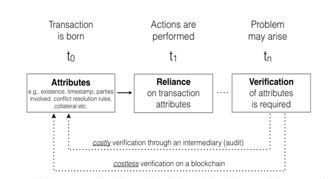 Figure 2: Costly Verification Through an Intermediary versus Costless Digital Verfication on a Blockchain
Figure 2: Costly Verification Through an Intermediary versus Costless Digital Verfication on a Blockchain
What Blockchain has tried is to push all these verification costs of transactions close to zero. Blockchain contributes in providing a costless verification. Every transaction taking place is recorded on the chain and allows to transfer money globally without using any intermediary or being censored. Any transaction attribute or information that is stored on the distributed ledger can be cheaply verified in real-time by any participant of that network. The trust in the intermediary becomes trust in the underlying code and consensus rules.
2.3 WORKING OF BLOCKCHAIN
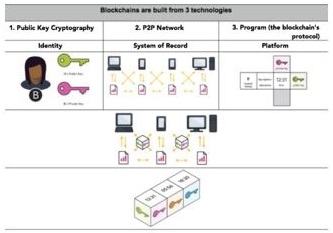 Figure 3: Building Blocks of Blockchain
Figure 3: Building Blocks of Blockchain
The main motive of Blockchain technology is to perform a secure transaction with digital identity reference.
Suppose two people say, A and B are present over the network and A wants to send money to B, both of them holds a Private key and Public key.
Now A taking its private key, performs transactions and attach it to Bs public key. A Block: containing digital signature, timestamp and information(data) is then broadcasted to all the nodes over the network(connected over P2P Network). This transaction must be authenticated by every node in the network.
The authentication is done on the basis of Digital Signature. The nodes verify the authenticity of A and thus prevent fraud and impersonation.
Once the digital Signature is authenticated, it gets pooled with other authenticated transactions into a Block. Each Block is encrypted using a cryptographic hash function.
Now in order to add the block to the main chain, it has to be validated. This involves Mining. For a Public Blockchain Network, mining works on the concept of Proof-of-work: some mathematical puzzles which the nodes have to solve in order to validate the transaction.
Once the mining is done, the block is validated and added to the main chain. Now the copy of ledger with all the nodes is updated.
The Miner, who did mining and validated the block gets some mining reward as well.
Thus, with this process, the transactions are decided by mathematics and consensus rules(protocols) and not the trust or intermediaries decisions.
3. APPLICATIONS WITH CASE STUDIES
3.1 MARKET SUPPLY-CHAIN RECORDS
Considering a case of farmers and buyers trading system. When a crop is produced and harvested by a farmer, it goes through cooling, cleaning, sorting and packaging before moving it to production. This process involves middle-men who take a lot of advantage of it and farmers almost never get a fair price for their crops. To connect farmers directly with the buyers without involving any middle-men(intermediaries), Blockchain, a decentralized, transparent system can be used. The data remains secure and there will be no price manipulation and thus will help farmers in getting a fair price for their crops.
DIGITAL CERTIFICATION SYSTEM: When the students graduate every year, they may got to other colleges, countries etc. for their higher studies. But the certificates, degrees they have been awarded with previously will still be required for new admission. Currently, various schools or universities provide a paper-only certificates to the students which the students need to collect in-person only. Also, when they apply to a company, their degree needs to be verified manually. A problem of fake certification is also a major concern in the present scenario. All these problems can be solved with the Blockchain platform. The degrees or certificates of the students can be stored on a single Blockchain network and thus can be easily accessible. A major point here is the authenticated and validated certificates will be stored and thus removing the problem of fake certifications.
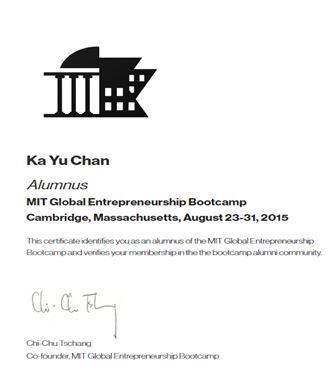 DECENTRALIZED MARKETPLACE: Blockchain being a decentralized platform, the same can be used to implement a fully distributed platform to enable free transactions between sellers and buyers. There will be no central authority to control it and transparency will be maintained.
DECENTRALIZED MARKETPLACE: Blockchain being a decentralized platform, the same can be used to implement a fully distributed platform to enable free transactions between sellers and buyers. There will be no central authority to control it and transparency will be maintained.
4. CONCLUSION
A lot has been emerged and implemented with respect to the Blockchain. While Blockchain is still evolving, a lot has to be explored in the future. Today digital world concerns data integrity and data security and this can be achieved successfully with Blockchain. The technology can replace the traditional trading system by providing immutable, transparent and distributed system. Shifting from centralized system to decentralized Blockchain system will take a huge leap in the field of digitalization with data security, integrity, authenticity and validity.
5. REFERENCES
[1] Mattila, Juri: The Blockchain Phenomenon The Disruptive Potential of Distributed Consensus Architectures
ETLA Working Papers, No. 38
[2] Roman Beck, Christoph Miller Bloch: Blockchain as Radical Innovation: A Framework for Engaging with Distributed Ledgers
[3] Leon, Stalick: Blockchain: Properties and Misconceptions
[4] Beck, Czepluch, Lollike, Malone: Blockchain- The Gateway To Trust-Free Cryptographic Transactions
[5] Catalini, S. Gans: Some Simple Economics of the Blockchain
[6] Wikipedia: Blockchain
[7] Digital Certificates Project: MIT Labs
